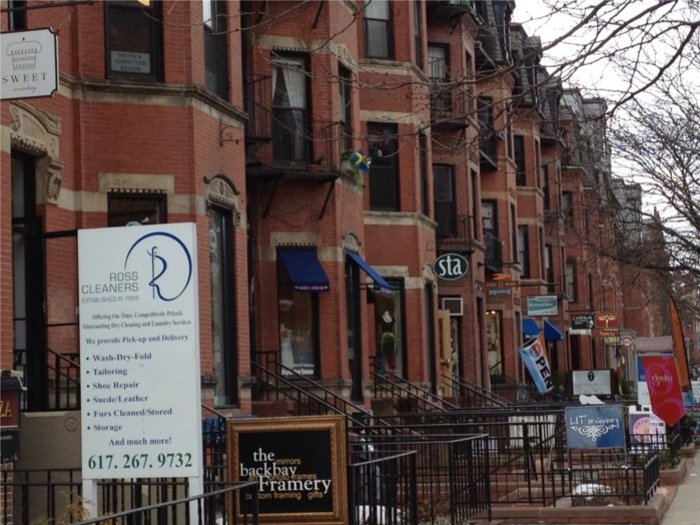 Location of Newbury Street within Boston. Source: Google. Google Maps (2013). Retrieved from http://maps.google.com.
Location of Newbury Street within Boston. Source: Google. Google Maps (2013). Retrieved from http://maps.google.com.
Nested within the Back Bay, Newbury Street is the delightful hub of activity, offering fashionable shopping venues and tasty dining options. Bordered by Boston’s greatest attractions, it thrives on business from tourists and locals. Its eclectic character and economic spectrum also attract a diverse audience. Thus, Newbury makes for a rich and diverse site within the city for study and observation.
I choose the eight blocks of Newbury between Massachusetts Avenue and the Boston Public Garden for two main reasons. One, it is one of Boston’s “epitome districts,” one of Boston’s many, encapsulating both the vibrant and diverse nature of Boston as a whole, as well as the eclectic and classy nature of the Back Bay.1 Two, because Newbury has several compelling developmental characteristics that I wanted to further explore.
First of all, it has a distinct socioeconomic spectrum. All of Newbury Street is catered to the middle class, but venues closer to Mass Ave are distinctly on the lower spectrum, whereas venues closer to the Boston Public Garden are distinctly upper middle class. This transition is tangible in both price range and visual architecture. Looking down Newbury from Mass Ave, the stores and restaurants seem small, old, and even dingy. Looking over from the Boston Public Garden, however, the venues look much larger and shinier, with glass window displays and fancy lettering. Did this transition arise organically, or was it structured by city planners? Also, how did the interaction of Newbury and its surrounding neighborhoods shape this characteristic? For example, perhaps the grid-like nature of the Back Bay neighborhood enhanced the divisions between different blocks on Newbury.
Secondly, Newbury is largely a pedestrian neighborhood, despite being bordered by the three main roads: Massachusetts Avenue, Commonwealth Avenue, and Boylston. How did Newbury’s commercial presence and contextual features influence the pedestrian culture? Perhaps, this is caused by the multitude of stores, the lack of parking, the narrow streets, or the accessibility from the Hynes Convention Center T stop. Vice versa, how did the pedestrian presence promote or demote Newbury’s commercial activity? Massachusetts Avenue and Boylston Street also fall along breaks, which Grady point to as places where “the city’s energies falter or shift gears.”2 Again, how has the presence of these different energies contributed to Newbury’s hype and vibe?
 View of Newbury Street's shops.
View of Newbury Street's shops.
Thirdly, it seems that most of Newbury’s fashion venues are well-established brands, whereas its restaurants and cafes are more eclectic and non-mainstream. For example, typical fashion stores include chain brands like Urban Outfitters, Ralph Lauren, North Face, and Forever 21. Many of the food venues, however, are exclusive to Newbury Street or Boston, such as Cafeteria Boston, Trident Booksellers and Cafe, and Sonsie. Is this pattern by coincidence, by design, or by influence? If by influence, was it economic, social, or other?
Finally, Newbury is surrounded by several of Boston’s other greatest attractions, including the Boston Public Garden to the east, the Charles River to the north, and the Hynes Convention Center and Prudential Center to the south. With so many sites vying for people’s attention, how was Newbury able to thrive? Did the other attractions supplement or compete for Newbury’s audience? More curiously, how was Newbury able to develop an image distinct from the Prudential Center, which is an equally major hub of food and fashion. Especially during the cold Boston months, the indoor environment of the Prudential Center would provide extra heating and insulation compared to the exposed environment of Newbury Street.
To summarize, I am interested in studying the developmental history of Newbury. How did it grow into one of Boston’s main attractions? How did its socioeconomic spectrum, pedestrian culture, and eclectic commercial venues develop? How did its surrounding environment, including nearby attractions and grid-like neighborhood, foster or suppress Newbury’s activity and character? Did Newbury organically arise or was it a manmade creation? I am eager to delve into the rich and complex background of my site through the course of the semester.